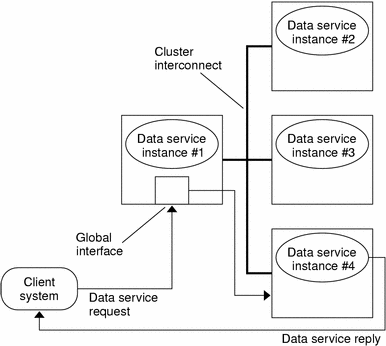Scalable Data Services
The primary goal of cluster networking is to provide scalability for data services. Scalability means that as the load offered to a service increases, a data service can maintain a constant response time to this increased workload as new nodes are added to the cluster and new server instances are run. A good example of a scalable data service is a web service. Typically, a scalable data service is composed of several instances, each of which runs on different nodes of the cluster. Together, these instances behave as a single service for a remote client of that service and implement the functionality of the service. A scalable web service with several httpd daemons that run on different nodes can have any daemon serve a client request. The daemon that serves the request depends on a load-balancing policy. The reply to the client appears to come from the service, not the particular daemon that serviced the request, thus preserving the single-service appearance.
The following figure depicts the scalable service architecture.
Figure 3–3 Scalable Data Service Architecture

The nodes that are not hosting the global interface (proxy nodes) have the shared address hosted on their loopback interfaces. Packets that are coming into the global interface are distributed to other cluster nodes, based on configurable load-balancing policies. The possible load-balancing policies are described next.
Load-Balancing Policies
Load balancing improves performance of the scalable service, both in response time and in throughput.
Two classes of scalable data services exist: pure and sticky. A pure service is one where any instance can respond to client requests. A sticky service has the cluster balancing the load for requests to the node. Those requests are not redirected to other instances.
A pure service uses a weighted load-balancing policy. Under this load-balancing policy, client requests are by default uniformly distributed over the server instances in the cluster. For example, in a three-node cluster where each node has the weight of 1, each node services one-third of the requests from any client on behalf of that service. Weights can be changed at any time through the scrgadm(1M) command interface or through the SunPlex Manager GUI.
A sticky service has two types: ordinary sticky and wildcard sticky. Sticky services allow concurrent application-level sessions over multiple TCP connections to share in-state memory (application session state).
Ordinary sticky services permit a client to share state between multiple concurrent TCP connections. The client is said to be “sticky” toward the server instance listening on a single port. The client is guaranteed that all requests go to the same server instance, if that instance remains up and accessible and the load balancing policy is not changed while the service is online.
Wildcard sticky services use dynamically assigned port numbers, but still expect client requests to go to the same node. The client is “sticky wildcard” over ports toward the same IP address.
- © 2010, Oracle Corporation and/or its affiliates
